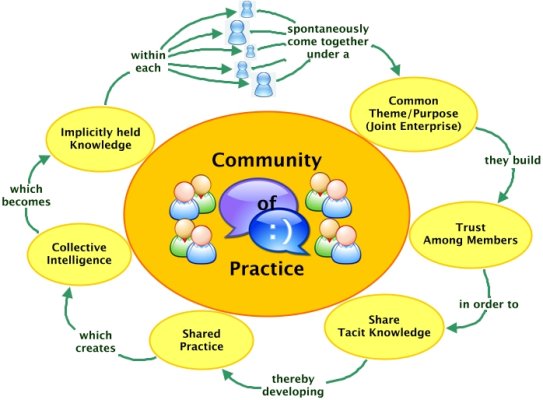This module focuses on creating a sense of community among session
attendees then facilitating the development of their participation in a community of practice.

Materials on This Page
- Voice Thread Used as a Discussion Thread Platform
- Sample Plan - Ongoing Professional Development Series Fostering Development of a Participatory Learning Community
- Welcome eMail to Participants
- Community Building Activities for F2F Session
- Final Thoughts on Communities of Practice
Sharing Ideas Using an Interactive Tool - Voice Thread
Teachers comment via text, video, or voice to contribute to the
discussion and reflect on each others' comments.
Ongoing Professional Development - Sample Plan
Professional Development Series Delivered Using
Blended Learning Model and Job-Embedded Training
Outline of Considerations to Facilitate and Support Community
Strategies to Facilitate and Maintain Community Connections
Hover Over the Image Below to View More Information on Each Component

Reflection on Communities of Practice
Whether in an online forum or a face-to-face professional learning opportunity with only three people, the common elements of community building are meeting individual needs, skills, and interests. A community of practice is self-selected and interaction is completely based on personal preferences. This is the first thing that I want teachers to understand. This is not extra work - it is essential networking that will help one continue to grow as a professional.
Sharing the personal benefits that I enjoy by participating in various communities of practice might inspire some teachers, however I feel the best thing I can do for teachers is help them to identify areas of interest them help them connect. The best teachers I know stand on the shoulders of giants. They use others’ ideas a springboards for their own. Communities of like-minded people can also give teachers invaluable, impartial feedback. This is particularly important for teachers working in small schools who may be the only teacher of a content area. Working in a vacuum is the kiss of death in teaching - one can’t help but stagnate without interacting with other educators.
Teachers may not realize that they are already a part of a community of practice. Pointing out that joining Facebook groups or following boards from individuals they respect on Pinterest may help them see that this is not extra work and that the tools they already use can be further leveraged to expand their network.
Just last summer I began to facilitate the development of a community of practice with a math group providing professional development at a university in my area. I set up an Edmodo then trained teachers how to use it to maintain connections with session participants, and other educators, and groups existing in the platform. Had I worked through this module prior to that session, I would have placed greater emphasis on activities to develop community in the room using icebreakers prior to sharing Edmodo. Icebreakers would have been a nice segway to the online platform since teachers would have already met other teachers who they would be interested in connecting with after the session ended.
A virtual environment affords networking that is neither time nor place bound. This is critical for teachers whose work-life balance never quite seems to be in balance. Teachers can connect with their communities at their convenience. That said, there is something special about an in-person connection that is hard to duplicate online. For me, the ideal personal learning community will consist of both face-to-face and virtual connections.